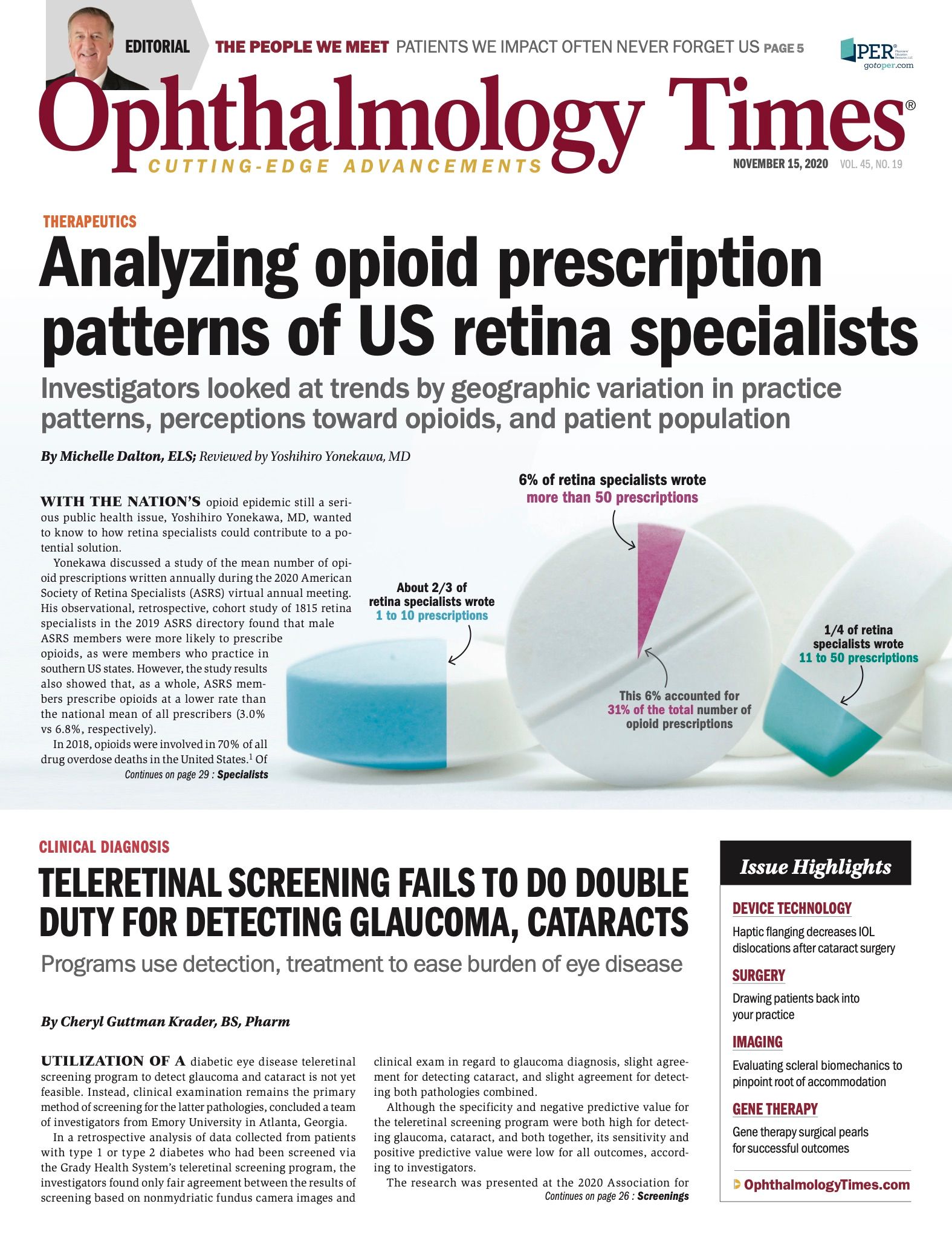- COVID-19
- Biosimilars
- Cataract Therapeutics
- DME
- Gene Therapy
- Workplace
- Ptosis
- Optic Relief
- Imaging
- Geographic Atrophy
- AMD
- Presbyopia
- Ocular Surface Disease
- Practice Management
- Pediatrics
- Surgery
- Therapeutics
- Optometry
- Retina
- Cataract
- Pharmacy
- IOL
- Dry Eye
- Understanding Antibiotic Resistance
- Refractive
- Cornea
- Glaucoma
- OCT
- Ocular Allergy
- Clinical Diagnosis
- Technology
FA implant outperforms anti-VEGF in DR patients lost to follow-up
Study results could provide a new preferred treatment paradigm for this population.

This article was reviewed by Caesar K. Luo, MD, FACS
Patients with diabetic macular edema (DME) and high-risk diabetic retinopathy (DR) treated with the fluocinolone acetonide (FA) implant (Iluvien, Alimera Sciences) who were lost to follow-up care for more than 6 months had better vision and more stable disease upon re-presentation to the clinic compared with patients treated with intravitreal anti-VEGF therapy, according to data presented during the 2020 American Society of Retina Specialists virtual annual meeting.
These results could provide a new preferred treatment paradigm for this population, as patients with diabetes have higher rates of treatment nonadherence than patients with other eye diseases.
The reasons for this are multifold and include the greater number of comorbid conditions in the diabetic population, age, and issues with insurance access.
Related: FA implant outperforms anti-VEGF in DR patients lost-to-follow-up
Study design
Caesar K. Luo, MD, FACS, Bay Area Retina Associates, presented data from a retrospective, time-matched series collected from the Vestrum Health database from January 2013 to August 2019.
The study included 344 eyes treated with the fluocinolone acetonide implant and 15,510 eyes treated with anti-VEGF therapy.
To be included, patients had to have clinically significant DME, moderate or severe DR, and a more than 6-month break in follow-up in the first 2 years. Eyes with panretinal photocoagulation or previous vitrectomy were excluded, he noted.
“Between the last treatment date and the return visit was around 8 months for the fluocinolone acetonide subgroup and nearly 9 months for the anti-VEGF subgroup,” Luo said. “The majority of eyes in the fluocinolone acetonide group had a diagnosis of moderate nonproliferative DR (NPDR), whereas in the anti-VEGF group, the majority of eyes were reported with severe NPDR.”
Related: Identifying risk factors for severe diabetic eye disease
Researchers analyzed visual acuity, central subfield thickness, and IOP changes, as well as the incidence of vitreous hemorrhage, tractional retinal detachment, and iris neovascularization.
Results
The implant group had better functional and anatomic outcomes overall. Patients in the implant arm had a letter gain (79.8 to 80.6 letters) while the anti-VEGF group experienced a letter loss (76.8 to 72.5 letters).
“The fluocinolone acetonide arm had [stable] visual acuity following the break. While the anti-VEGF arm showed a 2.7-letter loss, both arms showed stability in intraocular pressure before and after the treatment break,” Luo said. “Anatomic outcomes were favorable for the fluocinolone acetonide arm with a 24 μm reduction in central subfield thickness after the break, while the anti-VEGF arm demonstrated a 7 μm increase after the break.”
Incidence of proliferative events such as tractional retinal detachments and iris neovascularization were fewer in the implant arm as well.
Retinal detachment, iris neovascularization, and vitreous hemorrhage occurred less often in the implant group than the anti-VEGF group (1% versus 4%, 1% versus 5%, and 7% versus 34%, respectively). The implant group also had greater disease stability.
Related: Study associates frequent anti-VEGF injections with risk of mild cognitive impairment
“In eyes with moderate NPDR prior to the break, 99% of fluocinolone acetonide eyes were stable, whereas 7% of anti-VEGF–treated eyes showed a progression of retinopathy,” Luo said. “In eyes with severe NPDR, 99% of eyes in the fluocinolone acetonide arm had stable or improved retinopathy, with a single eye progressing to proliferative retinopathy. However, in the anti-VEGF arm, 10% of eyes had progressed to proliferative retinopathy at the return visit.”
Importantly, mean and median IOP were not different in the pre- and post-treatment implant arm. Glaucoma is a concern in patients who receive the fluocinolone acetonide implant.
Although Luo recommends looking at those data further, the implant group “did not have any patients [who] needed filtering surgery or any secondary treatment for glaucoma progression,” he said.
During the paper discussion, Jack Wells, MD, University of South Carolina, asked if any evidence was found to determine whether eyes in the fluocinolone group that had progression of glaucoma or developed glaucoma, required glaucoma therapy or surgery.
Related: Single administration of intracameral bimatoprost implant: IOP lowering, safety
“That’s really the thing that we were first worried about in looking at fluocinolone acetonide implant,” Luo said. “Since this is a Vestrum database analysis, we have only what’s available in the electronic medical records. The mean and median IOP [were] not different in pre- and post-treatment, but we did look at the full 3-year treatment” and none of the 363 eyes needed filtering surgery or any secondary treatment for glaucoma progression.
“Was there a difference in DR progression? What would be the mechanism where steroids would reduce retinopathy progression?” Wells asked.
Luo noted that the time to first event is similar between the data presented here and in the pivotal trials. “While the inflammatory response is not the primary driver for proliferation, it is part of the process. Steroids can reduce some VEGF levels as well. Maybe not as robustly as anti-VEGF therapy, but it can reduce them,” he said, and advised clinicians who think their patients may not adhere to follow-up to consider using steroid implants.
Read more by Michelle Dalton
--
Caesar K. Luo, MD, FACS
p: 510-832-6554
Luo has no financial interests related to this content.

